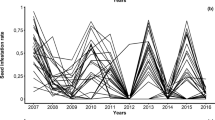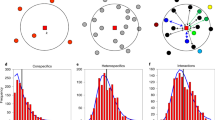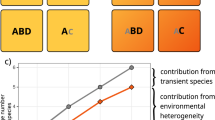Abstract
Understanding spatial population dynamics is fundamental for many questions in ecology and conservation1,2,3,4. Many theoretical mechanisms have been proposed whereby spatial structure can promote population persistence, in particular for exploiter–victim systems (host–parasite/pathogen, predator–prey) whose interactions are inherently oscillatory and therefore prone to extinction of local populations5,6,7,8,9,10,11. Experiments have confirmed that spatial structure can extend persistence11,12,13,14,15,16, but it has rarely been possible to identify the specific mechanisms involved. Here we use a model-based approach to identify the effects of spatial population processes in experimental systems of bean plants (Phaseolus lunatus), herbivorous mites (Tetranychus urticae) and predatory mites (Phytoseiulus persimilis). On isolated plants, and in a spatially undivided experimental system of 90 plants, prey and predator populations collapsed; however, introducing habitat structure allowed long-term persistence. Using mechanistic models, we determine that spatial population structure did not contribute to persistence, and spatially explicit models are not needed. Rather, habitat structure reduced the success of predators at locating prey outbreaks, allowing between-plant asynchrony of local population cycles due to random colonization events.
This is a preview of subscription content, access via your institution
Access options
Subscribe to this journal
Receive 51 print issues and online access
$199.00 per year
only $3.90 per issue
Buy this article
- Purchase on Springer Link
- Instant access to full article PDF
Prices may be subject to local taxes which are calculated during checkout




Similar content being viewed by others
References
Tilman, D. & Kareiva, P. (eds) Spatial Ecology: the Role of Space in Population Dynamics and Interspecific Interactions (Princeton Univ. Press, Princeton, 1997).
Dieckmann, U., Law, R. & Metz, J. A. J. (eds) The Geometry of Ecological Interactions: Simplifying Spatial Complexity (Cambridge Univ. Press, Cambridge, 2000).
Hanski, I. A. & Gilpin, M. E. (eds) Metapopulation Biology: Ecology, Genetics, and Evolution (Academic, San Diego, 1997).
Levin, S. A., Grenfell, B., Hastings, A. & Perelson, A. S. Mathematical and computational challenges in population biology and ecosystems science. Science 275, 334–343 (1997).
May, R. M. Host–parasitoid systems in patchy environments: a phenomenological model. J. Anim. Ecol. 47, 833–843 (1978).
Sabelis, M. W. & Diekmann, O. Overall population stability despite local extinction: the stabilizing effect of prey dispersal from predator-invaded patches. Theor. Popul. Biol. 34, 169–176 (1988).
Hassell, M. P. & May, R. M. Spatial heterogeneity and the dynamics of parasitoid–host systems. Ann. Zool. Fenn. 25, 55–61 (1988).
Hassell, M. P., Comins, H. N. & May, R. M. Spatial structure and chaos in insect population dynamics. Nature 353, 255–258 (1991).
de Roos, A. M., McCauley, E. & Wilson, W. Mobility versus density limited predator–prey dynamics on different spatial scales. Proc. R. Soc. Lond. B 246, 117–122 (1991).
Sabelis, M. W., Diekmann, O. & Jansen, V. A. A. Metapopulation persistence despite local extinction—predator–prey patch models of the Lotka-Volterra type. Biol. J. Linn. Soc. 42, 267–283 (1991).
Murdoch, W. W. Population regulation in theory and practice. Ecology 75, 271–287 (1994).
Huffaker, C. B., Shea, K. P. & Herman, S. G. Experimental studies on predation: complex dispersion and levels of food in an acarine predator–prey interaction. Hilgardia 34, 305–330 (1963).
van de Klashorst, G., Readshaw, G. L., Sabelis, M. W. & Lingeman, R. A demonstration of asynchronous local cycles in an acarine predator–prey system. Exp. Appl. Acarol. 14, 185–199 (1992).
Holyoak, M. & Lawler, S. P. Persistence of an extinction prone predator–prey interaction through metapopulation dynamics. Ecology 77, 1867–1879 (1996).
Janssen, A., van Gool, E., Lingeman, R., Jacas, J. & van de Klashorst, G. Metapopulation dynamics of a persisting predator–prey system in the laboratory: time-series analysis. Exp. Appl. Acarol. 21, 415–430 (1997).
Holyoak, M. Habitat patch arrangement and metapopulation persistence of predators and prey. Am. Nat. 156, 378–389 (2000).
Pels, B. & Sabelis, M. W. Local dynamics, overexploitation and predator dispersal in an acarine predator–prey system. Oikos 86, 573–583 (1999).
McCauley, E. et al. Inferring colonization processes from population dynamics in spatially structured predator–prey systems. Ecology 81, 3350–3361 (2000).
McCauley, E., de Roos, A. M. & Wilson, W. Dynamics of age- and spatially-structured predator–prey interactions: individual based models and population level formulations. Am. Nat. 142, 412–442 (1993).
de Roos, A. M., McCauley, E. & Wilson, W. Pattern formation and the spatial scale of interactions between predators and their prey. Theor. Popul. Biol. 53, 108–130 (1998).
Nisbet, R. M. & Gurney, W. S. C. Modelling Fluctuating Populations Ch. 10 (Wiley, New York, 1982).
Helle, W. & Sabelis, M. W. (eds) Spider Mites, their Biology, Natural Enemies, and Control (Elsevier, Amsterdam, 1985).
Sabelis, M. W. & van der Meer, J. in Dynamics of Physiologically Structured Populations (eds Metz, J. A. J. & Diekmann, O.) 322–344 (Springer, New York, 1986).
Hastings, A. Spatial heterogeneity and stability of predator–prey systems. Theor. Popul. Biol. 12, 37–48 (1977).
Wright, S. Isolation by distance. Genetics 28, 114–138 (1943).
Gurney, W. S. C., Nisbet, R. M. & Lawton, J. H. The systematic formulation of tractable single-species population models incorporating age structure. J. Anim. Ecol. 52, 479–495 (1983).
Caswell, H. Matrix Population Models: Construction, Analysis, and Interpretation (Sinauer Associates, Sunderland, Massachusetts, 2001).
Sabelis, M. W. How to analyze prey preference when prey density varies? A new method to discriminate between effects of gut fullness and prey type composition. Oecologia 82, 289–298 (1990).
Sabelis, M. W. & Nagelkerke, C. J. Sex allocation strategies of pseudoarrhenotokous phytoseiid mites. Neth. J. Zool. 37, 117–136 (1987).
Acknowledgements
We thank E. van Gool for assistance with the experiments. This work was undertaken as part of the Working Group on Complex Population Dynamics at the National Center for Ecological Analysis and Synthesis, a centre funded by the US National Science Foundation, University of California–Santa Barbara, and the State of California. A.J. and M.W.S. carried out experiments; E.M., B.E.K., C.J.B. and S.N.W. conceived and fitted colonization models; S.P.E., S.N.W., P.R.H., A.J., P.T., R.M.N. and W.W.N. conceived and fitted structured population models; S.P.E., P.R.H., S.N.W. and C.J.B. implemented the models; S.P.E., E.M. and B.E.K. carried out comparisons of models with data; and S.P.E., E.M., A.J., M.W.S. and P.R.H. prepared the original manuscript.
Author information
Authors and Affiliations
Corresponding author
Supplementary information

Figure 1
(GIF 10.6 KB)
Metapopulation swapping experiments
The Metapopulation Swapping experiments followed the same protocols as the two Metapopulation experiments described in the text, again having two replicate systems operating simultaneously in the same environmental chamber and given identical inoculations of mites. In the "swapping" replicate of this experiment, on each census date plants were paired at random and the locations of paired plants were interchanged; in the "control" replicate plants remained in place. All other experimental procedures were the same as in the Metapopulation experiments described in the text. The figure below shows the fluctuations in the total density of prey (circles) and predatory (triangles) mites in the control (open symbols) and swapping (solid symbols) replicates. The experimental results are consistent with our conclusion that spatial pattern did not play an important role in the dynamics of the Metapopulation systems, in that a significant manipulation of the populations' spatial structure had very little effect on short-term dynamics. However the duration of the swapping experiment was only 91d, which is shorter than the extinction time of the SuperIsland experiment and consequently too brief to determine if long-term persistence would occur.
Rights and permissions
About this article
Cite this article
Ellner, S., McCauley, E., Kendall, B. et al. Habitat structure and population persistence in an experimental community. Nature 412, 538–543 (2001). https://doi.org/10.1038/35087580
Received:
Accepted:
Published:
Issue Date:
DOI: https://doi.org/10.1038/35087580
This article is cited by
-
Optimal dispersal and diffusion-enhanced robustness in two-patch metapopulations: origin’s saddle-source nature matters
Theory in Biosciences (2024)
-
Early stage ecological communities on artificial algae showed no difference in diversity and abundance under ocean acidification
Hydrobiologia (2023)
-
Behavioral state resource selection in invasive wild pigs in the Southeastern United States
Scientific Reports (2021)
-
Community and single cell analyses reveal complex predatory interactions between bacteria in high diversity systems
Nature Communications (2021)
-
Long-term cyclic persistence in an experimental predator–prey system
Nature (2020)
Comments
By submitting a comment you agree to abide by our Terms and Community Guidelines. If you find something abusive or that does not comply with our terms or guidelines please flag it as inappropriate.



